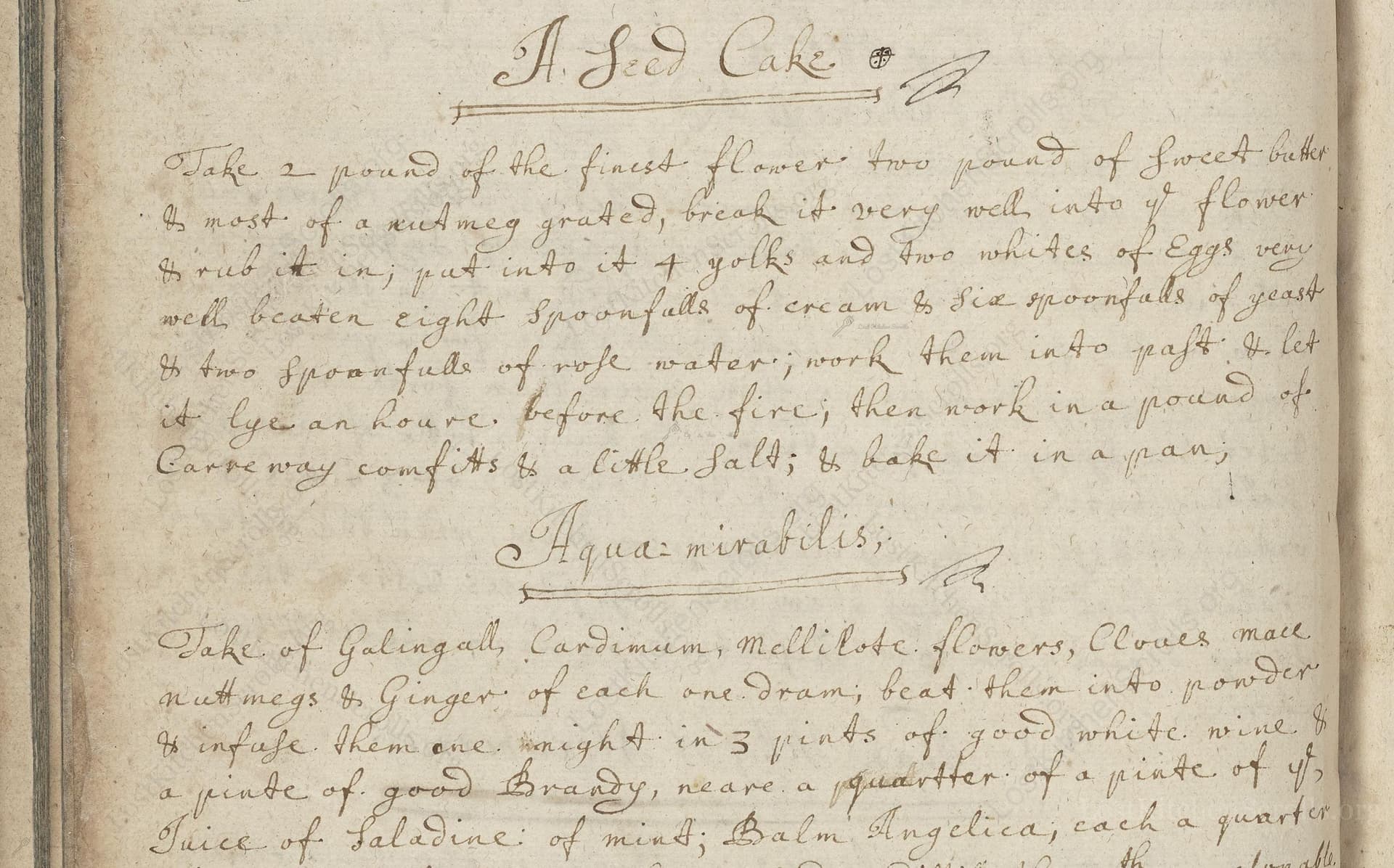Seed Cake
From the treasured pages of Cookbook of Jane Dawson
Written by Jane Dawson

Seed Cake
"Take 2 pound of the finest flower: two pound of Sweet butterr & most. of a nutmeg grated, break it very well, into ye flower & rub it in; put into it 4 yolks and two whites of Eggs very well beaten eight Spoonfulls of cream & Six Spoonfulls of yeast & two Spoonfulls of rose water; work them into past: & let it lye an houre. before the fire; then work in a pound of Currans very comfits & a little Salt; & bake it in a pan;"
Note on the Original Text
Seventeenth-century recipes were written as rough guides, assuming the cook knew basic techniques and measurements. Quantities, where given, were substantial, intended for large households; time and temperature were judged by eye and touch ("let it lye an houre. before the fire; then...bake it in a pan;"). 'Past' means 'paste' (dough), while 'flower' is simply our 'flour.' Capitalization, punctuation, and spelling were highly irregular, offering a charming window into the literary habits of the period.

Title
Cookbook of Jane Dawson (1690)
You can also click the book image above to peruse the original tome
Writer
Jane Dawson
Era
1690
Publisher
Unknown
Background
A delightful glimpse into late 17th-century English kitchens, Jane Dawson's recipe collection is a flavorful tapestry of sweet delicacies and savory dishes, revealing the tastes and ingenuity of bygone home cooks.
Kindly made available by
Folger Shakespeare Library
This recipe hails from the late 17th century and is attributed to Jane Dawson, a notable Englishwoman whose personal recipe book gives historians rare insight into domestic cookery of the upper and middling classes. Seed cakes like this were favored teatime treats and festive bakes, rich with butter, cream, and exotic flavorings such as rose water and imported spices—a clear marker of status and access to global trade. This Seed Cake reflects the transition in English baking from heavy, dense breads to lighter, yeasted cakes enjoyed with tea in the burgeoning social ritual that flourished in the period.

The recipe originally would have been assembled in a large glazed earthenware or wooden bowl, using a hand grater for the nutmeg and implements such as spoons and wooden paddles for mixing. Rising was achieved by placing the dough near a warm hearth or oven. Baking occurred in a metal or earthenware pan, probably set within a wood-fired oven or over coals, with hot embers placed above and below for even cooking—a far cry from today’s regulated ovens, but effective for the skilled housewives and cooks of the period.
Prep Time
1 hr 30 mins
Cook Time
1 hr
Servings
16
We've done our best to adapt this historical recipe for modern kitchens, but some details may still need refinement. We warmly welcome feedback from fellow cooks and culinary historians — your insights support the entire community!
Ingredients
- 2 pounds (about 7 cups) plain white flour (all-purpose)
- 2 pounds (4 cups) unsalted butter (softened)
- 1 whole nutmeg (mostly grated)
- 4 large egg yolks
- 2 large egg whites
- 1/2 cup heavy cream
- 1/3 cup fresh yeast (or 3/4 ounce instant dried yeast)
- 2 tablespoons rose water
- 1 pound (2 1/4 cups) currants (or substitute sultanas/raisins)
- 3.5 ounces (about 1/2 cup) sugar-coated comfits (or candied fennel/anise seeds)
- Pinch of salt
Instructions
- Begin by sifting 2 pounds (about 7 cups) of plain (all-purpose) flour into a large mixing bowl.
- Grate in most of a whole nutmeg and add to the flour.
- Cut 2 pounds (4 cups) of unsalted butter into cubes and rub it thoroughly into the flour until the mixture resembles fine breadcrumbs.
- In a separate bowl, beat 4 egg yolks and 2 egg whites until light and frothy.
- Next, combine the eggs with 1/2 cup of heavy cream, 1/3 cup of fresh baker's yeast (or use 3/4 ounce of modern instant yeast dissolved in the cream as a substitute), and 2 tablespoons of rose water.
- Mix the wet ingredients into the flour mixture to form a soft, sticky dough.
- Knead gently, then cover and leave it to rise by a warm place, ideally near a fire or warm oven (or use a modern proofing box or warm spot in your kitchen) for about 1 hour or until slightly risen.
- Finally, mix in 1 pound (2 1/4 cups) of cleaned currants (or substitute with sultanas/raisins if unavailable), some sugar-coated comfits (or candied fennel or anise seeds for a similar effect), and a pinch of salt.
- Transfer the dough to a baking pan and bake at 350°F for about 1 hour, or until golden and cooked through.
Estimated Calories
665 per serving
Cooking Estimates
It takes about 30 minutes to prepare the ingredients and mix the dough, plus an hour for rising, and about 1 hour to bake. Each serving provides a rich, buttery, and gently spiced sweet bread.
As noted above, we have made our best effort to translate and adapt this historical recipe for modern kitchens, taking into account ingredients nowadays, cooking techniques, measurements, and so on. However, historical recipes often contain assumptions that require interpretation.
We'd love for anyone to help improve these adaptations. Community contributions are highly welcome. If you have suggestions, corrections, or cooking tips based on your experience with this recipe, please share them below.
Join the Discussion
Rate This Recipe

Den Bockfisch In Einer Fleisch Suppen Zu Kochen
This recipe hails from a German manuscript cookbook compiled in 1696, a time whe...

Die Grieß Nudlen Zumachen
This recipe comes from a rather mysterious manuscript cookbook, penned anonymous...

Ein Boudain
This recipe comes from an anonymous German-language manuscript cookbook from 169...

Ein Gesaltzen Citroni
This recipe, dating from 1696, comes from an extensive anonymous German cookbook...
Browse our complete collection of time-honored recipes



